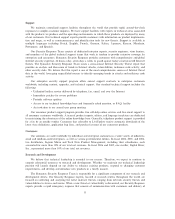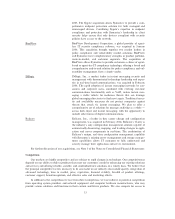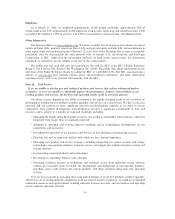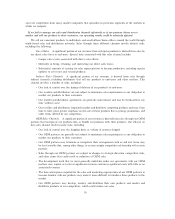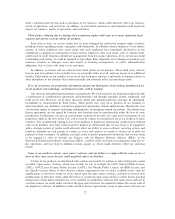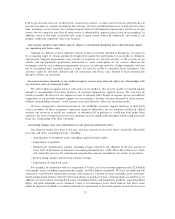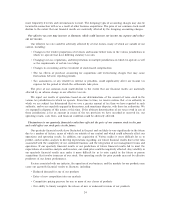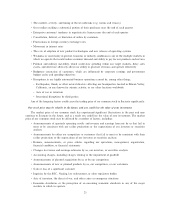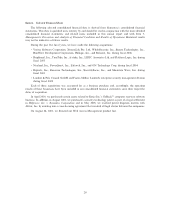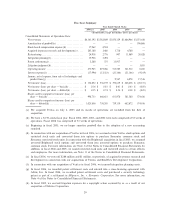Symantec 2006 Annual Report Download - page 27
Download and view the complete annual report
Please find page 27 of the 2006 Symantec annual report below. You can navigate through the pages in the report by either clicking on the pages listed below, or by using the keyword search tool below to find specific information within the annual report.large-scale computing environments with different operating systems, system management software, and
equipment and networking configurations, which may cause errors or failures in our products or may expose
undetected errors, failures, or bugs in our products. Our customers' computing environments are often
characterized by a wide variety of standard and non-standard configurations that make pre-release testing for
programming or compatibility errors very difficult and time-consuming. In addition, despite testing by us and
others, errors, failures, or bugs may not be found in new products or releases until after commencement of
commercial shipments. In the past, we have discovered software errors, failures, and bugs in certain of our
product offerings after their introduction and have experienced delayed or lost revenues during the period
required to correct these errors.
Errors, failures, or bugs in products released by us could result in negative publicity, product returns, loss
of or delay in market acceptance of our products, loss of competitive position, or claims by customers or
others. Many of our end-user customers use our products in applications that are critical to their businesses
and may have a greater sensitivity to defects in our products than to defects in other, less critical, software
products. In addition, if an actual or perceived breach of information integrity or availability occurs in one of
our end-user customer's systems, regardless of whether the breach is attributable to our products, the market
perception of the effectiveness of our products could be harmed. Alleviating any of these problems could
require significant expenditures of our capital and other resources and could cause interruptions, delays, or
cessation of our product licensing, which could cause us to lose existing or potential customers and could
adversely affect our operating results.
If we are unable to attract and retain qualified employees, lose key personnel, fail to integrate
replacement personnel successfully, or fail to manage our employee base effectively, we may be unable to
develop new and enhanced products and services, effectively manage or expand our business, or increase our
revenues.
Our future success depends upon our ability to recruit and retain our key management, technical, sales,
marketing, finance, and other critical personnel. Our officers and other key personnel are employees-at-will,
and we cannot assure you that we will be able to retain them. Competition for people with the specific skills
that we require is significant. In order to attract and retain personnel in a competitive marketplace, we believe
that we must provide a competitive compensation package, including cash and equity-based compensation.
The volatility in our stock price may from time to time adversely affect our ability to recruit or retain
employees. In addition, we may be unable to obtain required stockholder approvals of future increases in the
number of shares available for issuance under our equity compensation plans, and recent changes in
accounting rules require us to treat the issuance of employee stock options and other forms of equity-based
compensation as compensation expense. As a result, we may decide to issue fewer equity-based incentives and
may be impaired in our efforts to attract and retain necessary personnel. If we are unable to hire and retain
qualified employees, or conversely, if we fail to manage employee performance or reduce staffing levels when
required by market conditions, our business and operating results could be adversely affected.
Key personnel have left our company in the past and there likely will be additional departures of key
personnel from time to time in the future. The loss of any key employee could result in significant disruptions
to our operations, including adversely affecting the timeliness of product releases, the successful implementa-
tion and completion of company initiatives, the effectiveness of our disclosure controls and procedures and our
internal control over financial reporting, and the results of our operations. In addition, hiring, training, and
successfully integrating replacement sales and other personnel could be time consuming, may cause additional
disruptions to our operations, and may be unsuccessful, which could negatively impact future revenues.
We are a party to several class action and derivative action lawsuits, which could require significant
management time and attention and result in significant legal expenses, and which could, if not
determined favorably, negatively impact our business, financial condition, results of operations, and cash
flows.
We have been named as a party to several class action and derivative action lawsuits, and we may be
named in additional litigation. The expense of defending such litigation may be costly and divert manage-
21


